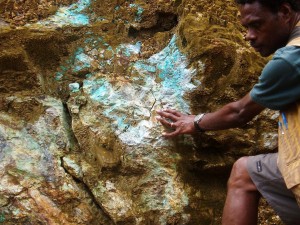Coppermoly Limited (ASX: COY): Simuku Copper-Moly Project
The Simuku project is a joint venture between Coppermoly and Barrick, read more background here. The project is well-located, being 32 kilometres southwest of Kimbe, the capital of West New Britain province in Papua New Guinea (“PNG”). Kimbe is a town of about 20,000 people and is the main export port for the large palm oil industry. It is also a very popular tourist destination with some of the best diving in the world.
The logistics at Simuku are unusually good for PNG and this would have a direct, positive effect on any future development. Similarly, relationships with the local land holders are good, helped by the fact locals do not live within the project area.
Simuku is prospective for three types of mineral deposit:
- large, low grade disseminated deposits of copper, +/ gold, +/ molybdenum (“moly”)
- high grade secondary copper blankets
- small but high grade, structurally related, molybdenum deposits
The project hosts a disseminated copper deposit; with an Inferred Resource of 200 million tonnes at a grade of 0.36% copper, 0.06g/t gold and 2g/t silver. While this is modest in size, recent drilling by Barrick has shown that mineralisation extends beneath the existing resource and along strike for at least 1,500 metres. This type of copper mineralisation is usually easy and inexpensive to process.
The primary, disseminated copper can be remobilised by ground water solutions and re-deposited as a secondary “blanket”, usually at a higher grade than the primary copper. This is indeed the case at Simuku. Secondary (supergene, for the technically-minded) copper intersections are in the range of 0.45% to 0.97% copper, along with minor gold and silver. Thus the copper grade has approximately doubled.
A resource has not yet been defined for the secondary copper at Simuku, but there is excellent potential for a resource in the 10’s of millions of tonnes with a grade in the range of 0.5% to 1.0% copper. However, much more work is required. The image below show secondary copper at surface that has yet to be tested.
The molybdenum potential at Simuku is more problematic. The geological setting is more complex and the size potential appears limited. However, trenching and drilling has shown some very good grades, in the range of 0.1% to 0.4% molybdenum, that are worthy of follow-up. By way of comparison, molybdenum-only open cut mine would typically have grades in the 0.1% to 0.2% range.
Last Word
This a superb project for a smaller resource company, but probably too small for Barrick, the world’s largest gold miner.
The secondary copper blanket could be the game changer at Simuku. It is very good grade, shallow, and amenable to low cost treatment. If a large enough resource is defined (20-40 million tonnes?), it would make the ideal “starter” operation for a junior explorer wishing to transition to development.
There is no reason to presume that the disseminated copper resource will not grow substantially in size. It is comparable in grade with similar deposits now being mined in PNG and the Americas. It is also a common occurrence that as drilling progresses in this type of deposit, high grade zones will be intersected.
The grade of the resource is probably too low to be of economic interest in its own right. However, it could almost certainly be mined should an operation be established to mine the secondary copper blanket.
2 April 2013
574 Word
Disclosure: Market Capital holds securities in Coppermoly Ltd as at the date of publication of this article.

